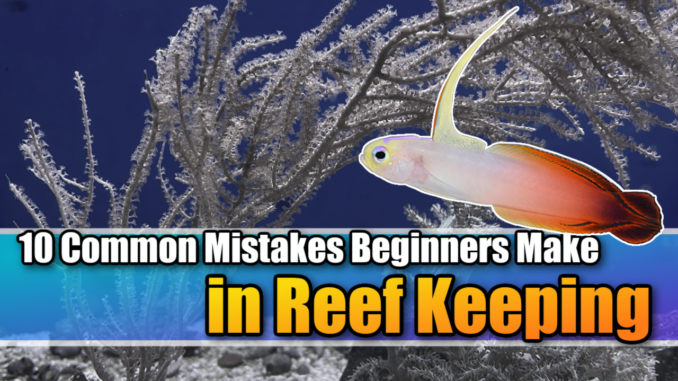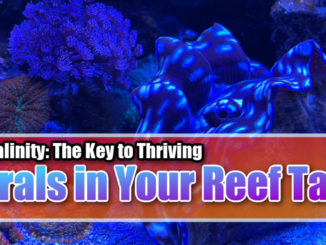
Getting started with a reef tank is an exciting venture. However, for beginners, the allure of vibrant corals and exotic fish can sometimes lead to inadvertent mistakes that may impact the health and longevity of a reef aquarium.
Understanding and avoiding these common pitfalls is crucial for cultivating a successful and sustainable marine environment. From insufficient research to neglecting water quality parameters, each aspect of reef keeping demands careful consideration. In this delicate ecosystem, missteps can have cascading effects, emphasizing the importance of informed decision-making and meticulous care.
Keeping a reef aquarium can be a rewarding but challenging hobby. Here are 10 common beginner mistakes in reef keeping that you should be aware of:
Insufficient Research:
One of the primary pitfalls in reef keeping is the tendency for beginners to dive in without thorough research. Failing to understand the specific needs and requirements of chosen coral and fish species can lead to challenges in maintaining optimal conditions.
A key takeaway for beginners is to invest time in comprehensive research, ensuring a well-informed approach to the care and maintenance of their marine ecosystem.
- Mistake: Jumping into reef keeping without thoroughly researching the needs and requirements of the chosen coral and fish species.
- Solution: Take the time to educate yourself on the specific care requirements of the organisms you plan to keep. Understand their environmental needs, behavior, and compatibility.
Inadequate Tank Cycling:
Overlooking the crucial process of reef tank cycling is a common misstep for novice reef keepers. Rushing to introduce fish and inverts without allowing the tank to cycle fully can disrupt the establishment of a stable and healthy environment.
This oversight hinders the growth of beneficial bacteria, essential for breaking down waste and maintaining water quality. Patience during the cycling phase is key, promoting the development of a robust biological filtration system that is fundamental to the success of a thriving reef aquarium.
- Mistake: Not properly cycling the aquarium before adding corals and fish.
- Solution: Allow the tank to cycle fully before introducing any livestock. This helps establish a stable and healthy environment by promoting the growth of beneficial bacteria.
Poor Water Quality Management:
Neglecting critical water quality parameters is a prevalent issue among beginner reef keepers. Overlooking factors such as reef tank parameters like temperature, salinity, pH, and nutrient levels can result in a compromised environment for marine life.
Regular monitoring and testing of these parameters, coupled with proactive measures like timely water changes, are essential to uphold a stable and thriving reef ecosystem. By addressing water quality concerns, novice enthusiasts can create an environment conducive to the health and vibrancy of their coral and fish inhabitants.
- Mistake: Neglecting water quality parameters such as temperature, salinity, pH, and nutrient levels.
- Solution: Regularly test and monitor water parameters. Perform water changes to maintain stable conditions and invest in quality equipment like protein skimmers and filtration systems.
Overstocking:
A common pitfall in reef keeping is the temptation to add too many fish or corals too quickly. Overstocking can lead to poor water quality, increased competition for resources, and heightened stress among the aquarium inhabitants.
Gradual introduction of livestock and careful consideration of the tank’s bio-load capacity are crucial for maintaining a balanced and healthy marine ecosystem.
- Mistake: Adding too many fish or corals too quickly.
- Solution: Gradually introduce livestock and pay attention to the tank’s bio-load capacity. Overstocking can lead to poor water quality, stress, and aggression among inhabitants.
Inadequate Lighting:
Overlooking the importance of appropriate lighting is a frequent mistake in reef keeping. Different coral species have specific lighting requirements for growth and well-being. Using improper or insufficient lighting can impede photosynthesis, hinder coral health, and impact the overall aesthetic appeal of the aquarium.
Investing in quality lighting systems that match the spectrum and intensity needed by the corals is essential. By understanding and meeting the lighting needs of the reef inhabitants, beginners can enhance the beauty and vitality of their underwater ecosystem.
- Mistake: Using inappropriate or insufficient lighting for coral growth.
- Solution: Research the lighting requirements of your specific corals and invest in quality lighting systems. Consider factors like spectrum, intensity, and duration of light exposure.
Ignoring Quarantine Procedures:
Neglecting to implement proper quarantine procedures is a common oversight in reef keeping. Introducing new fish or corals directly into the main tank without quarantine increases the risk of spreading diseases or parasites.
Setting up a separate quarantine tank allows hobbyist to observe and treat new additions before adding them into the display tank. This precautionary measure not only protects existing inhabitants but also promotes a healthier and disease-resistant reef environment.
By prioritizing quarantine, beginners can mitigate potential risks and ensure the long-term well-being of their reef tank.
- Mistake: Introducing new fish or corals to the main tank without quarantine.
- Solution: Set up a quarantine tank to observe and treat new additions for potential diseases or parasites before introducing them to the main display tank.
Improper Placement of Corals:
A common mistake among novice reef keepers is the improper placement of corals within the aquarium. Corals have varying preferences for lighting and water flow, and neglecting these considerations can lead to suboptimal conditions for their growth.
Some corals thrive in high light and strong flow, while others prefer lower intensity. Researching and understanding the specific requirements of each coral species is crucial.
Thoughtful placement, taking into account lighting and flow preferences, ensures that corals can flourish and contribute to the overall vibrancy of the reef ecosystem. By avoiding haphazard placement, beginners can create an environment that supports the health and beauty of their coral colonies.
- Mistake: Placing corals without considering their lighting and flow preferences.
- Solution: Research the lighting and flow requirements of each coral species and place them accordingly in the tank. Some corals prefer high light and flow, while others thrive in lower intensity.
Neglecting Regular Maintenance:
A common oversight in reef keeping is the failure to perform routine maintenance tasks. Consistent upkeep is essential for sustaining a healthy and thriving marine environment. Tasks such as regular water changes, equipment cleaning, and glass scraping contribute to stable water conditions and prevent the accumulation of debris and algae.
Ignoring these maintenance responsibilities can lead to deteriorating water quality, negatively impacting the well-being of coral and fish inhabitants. Establishing a regular maintenance schedule is paramount for the long-term success of a reef aquarium, allowing beginners to enjoy a visually stunning and sustainable underwater ecosystem.
- Mistake: Failing to perform routine maintenance tasks.
- Solution: Establish a regular maintenance schedule for tasks like water changes, equipment cleaning, and glass scraping. Consistent upkeep is crucial for a healthy reef environment.
Overlooking Temperature Fluctuations:
Failing to address temperature fluctuations is a common oversight in reef keeping. Maintaining a stable temperature is crucial for the health and well-being of marine life within the aquarium. Sudden changes in temperature can induce stress and negatively impact the immune systems of coral and fish.
Using a reliable aquarium heater, thermometer, and implementing temperature-monitoring practices are essential precautions. By ensuring a consistent and appropriate temperature range, beginners can create a stable and comfortable environment, promoting the overall resilience and vitality of their reef ecosystem.
- Mistake: Allowing significant temperature fluctuations in the aquarium.
- Solution: Use a reliable aquarium heater and thermometer to maintain a stable temperature. Sudden changes in temperature can stress or harm the inhabitants.
Impulse Buying:
Giving in to the excitement of reef keeping often leads to the common mistake of impulse buying. Acquiring new fish or corals on a whim without careful consideration of their compatibility, size, and care requirements can disrupt the balance of the aquarium.
This impulsive behavior may result in overcrowding, increased competition for resources, and potential conflicts among tank inhabitants.
It’s crucial for beginners to resist impulsive purchases and instead plan their aquarium carefully. Taking the time to research and choose species thoughtfully ensures a well-balanced and thriving reef tank in the long run.
- Mistake: Purchasing livestock on impulse without proper consideration.
- Solution: Plan your aquarium carefully, and resist the urge to buy species on a whim. Consider the long-term compatibility, size, and care requirements of each organism before making a purchase.
Addressing these and other common mistakes, this guide aims to provide insights and solutions to ensure a fulfilling and successful experience for those venturing into the captivating realm of reef aquariums. By adopting informed practices and meticulous care, beginners can navigate these challenges and create a thriving marine ecosystem within their own homes.




